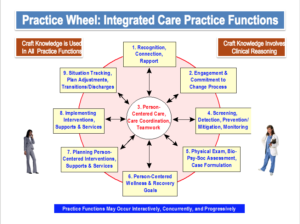Introduction
Click the play button below to hear this slide read by Dr. Neal Bowen.
While Treat First is flexible, it is not infinitely so. There are some key defining elements of Treat First, and in this module we’d like to introduce you to those. We will go through the six elements one by one, although by definition they are interdependent.
You’ll also see there is still flexibility in the specific way you practically
implement them. You will also recognize how, in an important sense, these elements are an invitation to modify certain aspects of organizational and professional culture to incorporate the attention to meeting the clients’ own reported needs before working on other aspects that service providers may see as needs. The agencies that have already been working with Treat First have all seen that this is in some ways the most difficult aspect of incorporating Treat First into ongoing workflows.
While Treat First is a different way of accessing services, it is NOT just a different assessment process.
Six Critical Elements
Click the play button below to hear this slide read by Dr. Neal Bowen.
The six elements we want to emphasize as critical are:
- Address the client’s needs first
- While this may seem obvious, it inverts the existing paradigm of completing a comprehensive assessment that was highly regulated as to content and process.
- Maintain the clinical integrity of the process
- Treat First as a process arose from the work of the Quality Service Review Process, which conceptualizes the clinical process of Behavioral Health Services according to the Practice Wheel, which we’ll describe in detail in a moment.
- Include other aspects of clinical care
- Treat First does not preclude the offering, or provision of needed services. It simply puts a priority on meeting the stated needs of the clients first.
- Improve client engagement
- Rather than performing an assessment according to regulatory requirements, Treat First helps clients collaborate in collecting information needed for a comprehensive assessment, in a natural and meaningful way.
- Increase client commitment
- In attending to the Practice Wheel, clients’ experience of Treat first tends to demonstrate that clients care about the services they receive because they see how they were developed to respond to the needs the clients recognize.
- Cultural Sensitivity
- Because Treat First necessarily personalizes the process of understanding what the client is seeking, and building a service plan based on that, it provides a context that is exquisitely open to the skilled provision of culturally sensitive services.

Intro to Talk 3
In Talk 3, we will be going over how to shift our approach toward our clients as we move toward the Treat First Concept.
